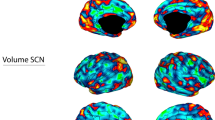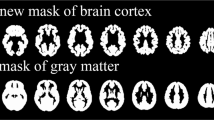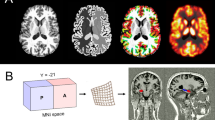Abstract
We yoked anatomical brain magnetic resonance imaging to a randomized, double-blind, placebo-controlled trial (RCT) of antidepressant medication for 10-week’s duration in patients with dysthymia. The RCT study design mitigated ascertainment bias by randomizing patients to receive either duloxetine or placebo, and it supported true causal inferences about treatment effects on the brain by controlling treatment assignment experimentally. We acquired 121 anatomical scans: at baseline and end point in 41 patients and once in 39 healthy controls. At baseline, patients had diffusely thicker cortices than did healthy participants, and patients who had thicker cortices had proportionately less severe symptoms. During the trial, symptoms improved significantly more in medication—compared with placebo-treated patients; concurrently, thicknesses in medication-treated patients declined toward values in healthy controls, but they increased slightly, away from control values, in placebo-treated patients. Changes in symptom severity during the trial mediated the association of treatment assignment with the change in thickness, suggesting that the beneficial effects of medication on symptom severity were at least partially responsible for normalizing cortical thickness. Together our findings suggest that baseline cortical hypertrophy in medication-free patients likely represented a compensatory, neuroplastic response that attenuated symptom severity. Medication then reduced symptoms and lessened the need for compensation, thereby normalizing thickness. This is to the best of our knowledge the first study to report within an RCT a differential change in cortical morphology during medication treatment for depressive illness and the first to provide within an RCT in vivo evidence for the presence of neuroanatomical plasticity in humans.
This is a preview of subscription content, access via your institution
Access options
Subscribe to this journal
Receive 12 print issues and online access
$259.00 per year
only $21.58 per issue
Buy this article
- Purchase on Springer Link
- Instant access to full article PDF
Prices may be subject to local taxes which are calculated during checkout




Similar content being viewed by others
References
Sansone RA, Sansone LA . Dysthymic disorder: forlorn and overlooked? Psychiatry (Edgmont) 2009; 6: 46–51.
American Psychiatric Association Diagnostic and Statistical Manual of Mental Disorders, 4th edn, DSM-IV-TR American Psychiatric Publishing: Washington, DC, USA, 2000.
Hellerstein DJ, Eipper JW. Dysthymia and chronic depression. In: Mann J, Roose SP, McGrath PJ (eds). The Clinical Handbook for the Management of Mood Disorders. Cambridge University Press: New York, USA, 2013, pp 20–36.
Anisman H, Ravindran AV, Griffiths J, Merali Z . Endocrine and cytokine correlates of major depression and dysthymia with typical or atypical features. Mol Psychiatry 1999; 4: 182–188.
Schlatter J, Ortuno F, Cervera-Enguix S . Differences in interleukins' patterns between dysthymia and major depression. Eur Psychiatry 2001; 16: 317–319.
Griffiths J, Ravindran AV, Merali Z, Anisman H . Dysthymia: a review of pharmacological and behavioral factors. Mol Psychiatrry 2000; 5: 242–261.
Weissman MM, Leaf PJ, Bruce ML, Florio L . The epidemiology of dysthymia in five communities: rates, risks, comorbidity, and treatment. Am J Psychiatry 1988; 145: 815–819.
Keller MB, Klein DN, Hirschfeld RMA, Kocsis JH, Mccullough JP, Miller I et al. Results of the DSM-IV mood disorders field trial. Am J Psychiatry 1995; 152: 843–849.
Solomon A, Haaga DAF, Arnow BA . Is clinical depression distinct from subthreshold depressive symptoms? A review of the continuity issue in depression research. J Nerv Ment Dis 2001; 189: 498–506.
Malykhin NV, Carter R, Hegadoren KM, Seres P, Coupland NJ . Fronto-limbic volumetric changes in major depressive disorder. J Affect Disord 2012; 136: 1104–1113.
McEwen BS . Mood disorders and allostatic load. Biol Psychiatry 2003; 54: 200–207.
Schmaal L, Veltman DJ, van Erp TGM, Penninx BWJH, Thompson PM, Hibar DP et al. Subcortical brain alterations in major depressive disorder: findings from the ENIGMA Major Depressive Disorder Working Group. Mol Psychiatry 2016; 21: 806–812.
Peterson BS, Warner V, Bansal R, Zhu H, Hao X, Liu J et al. Cortical thinning in persons at increased familial risk for major depression. Proc Natl Acad Sci USA 2009; 106: 6273–6278.
van Elst LT, Woermann FG, Lemieux L, Trimble MR . Amygdala enlargement in dysthymia - a volumetric study of patients with temporal lobe epilepsy. Biol Psychiatry 1999; 46: 1614–1623.
Ravindran AV, Smith A, Cameron C, Bhatla R, Cameron I, Georgescu TM et al. Toward a functional neuroanatomy of dysthymia: a functional magnetic resonance imaging study. J Affect Disord 2009; 119: 9–15.
Posner J, Hellerstein DJ, Gat I, Mechling A, Klahr K, Wang ZS et al. Antidepressants normalize the default mode network in patients with dysthymia. JAMA Psychiatry 2013; 70: 373–382.
Horga G, Kaur T, Peterson BS . Annual research review: Current limitations and future directions in MRI studies of child- and adult-onset developmental psychopathologies. J Child Psychol Psychiatry 2014; 55: 659–680.
Peterson BS . From correlations to causation: the value of preventive interventions in studying pathogenic mechanisms in childhood psychiatric disorders. J Child Psychol Psychiatry 2013; 54: 813–815.
Hellerstein DJ, Stewart JW, McGrath PJ, Deliyannides DA, Batchelder ST, Black SR et al. A randomized controlled trial of duloxetine versus placebo in the treatment of nonmajor chronic depression. J Clin Psychiatry 2012; 73: 984–991.
Hamilton M . A rating scale for depression. J Neurol Neurosurg Psychiatry 1960; 23: 56–62.
Hellerstein DJ, Batchelder ST, Lee A, Borisovskaya M . Rating dysthymia: an assessment of the construct and content validity of the Cornell Dysthymia Rating Scale. J Affect Disorders 2002; 71: 85–96.
Sled GJ, Zijdenbos AP, Evans AC . A nonparametric method for automatic correction of intensity nonuniformity in MRI data. IEEE Trans Med Imaging 1998; 17: 87–97.
Shattuck DW, Leahy RM . BrainSuite: an automated cortical surface identification tool. Med Image Anal 2002; 8: 129–142.
Shrout PE, Fleiss JL . Intraclass correlations: uses in assessing rater reliability. Psychol Bull 1979; 86: 420–428.
Haralick R, Shapiro L . Computer and Robot Vision Vol. 1. Addison-Wesley Publishing Company: Reading, MA, USA, 1992.
Qiu L, Lui S, Kuang W, Huang X, Li J, Li J et al. Regional increases of cortical thickness in untreated, first-episode major depressive disorder. Transl Psychiatry 2014; 4: e378.
Kempton MJ, Salvador Z, Munafo MR, Geddes JR, Simmons A, Frangou S et al. Structural neuroimaging studies in major depressive disorder meta-analysis and comparison with bipolar disorder. Arch Gen Psychiatry 2011; 68: 675–690.
Miller L, Bansal R, Wickramaratne P, Hao X, Tenke CE, Weissman MM et al. Neuroanatomical correlates of religiosity and spirituality: a study in adults at high and low familial risk for depression. JAMA Psychiatry 2014; 71: 128–135.
Pascual-Leone A, Amedi A, Fregni F, Merabet LB . The plastic human brain cortex. Annu Rev Neurosci 2005; 28: 377–401.
Zatorre RJ, Fields RD, Johansen-Berg H . Plasticity in gray and white: neuroimaging changes in brain structure during learning. Nat Neurosci 2012; 15: 528–536.
Fox KCR, Nijeboer S, Dixon ML, Floman JL, Ellamil M, Rumak SP et al. Is meditation associated with altered brain structure? A systematic review and meta-analysis of morphometric neuroimaging in meditation practitioners. Neurosci Biobehav Rev 2014; 43: 48–73.
Hotting K, Roder B . Beneficial effects of physical exercise on neuroplasticity and cognition. Neurosci Biobehav Rev 2013; 37: 2243–2257.
Stine-Morrow EAL, Basak C. Cognitive interventions. In: Schaie KW, Willis SL (eds). Handbook of the Psychology of Aging, 7th edn. Academic Press: Oxford, UK, 2011, pp 153–171.
Greenoug Wt, Volkmar FR, Juraska JM . Effects of rearing complexity on dendritic branching in frontolateral and temporal cortex of rat. Exp Neurol 1973; 41: 371–378.
Kozorovitskiy Y, Gross CG, Kopil C, Battaglia L, McBreen M, Stranahan AM et al. Experience induces structural and biochemical changes in the adult primate brain. Proc Natl Acad Sci USA 2005; 102: 17478–17482.
Blumenfeld-Katzir T, Pasternak O, Dagan M, Assaf Y . Diffusion MRI of structural brain plasticity induced by a learning and memory task. PLoS ONE 2011; 6: e20678.
Nilsson M, Perfilieva E, Johansson U, Orwar O, Eriksson PS . Enriched environment increases neurogenesis in the adult rat dentate gyrus and improves spatialmemory. J Neurobiol 1999; 39: 569–578.
Ramachandran VS, Hirstein W . The perception of phantom limbs - The D.O. Hebb lecture. Brain 1998; 121: 1603–1630.
Taub E, Uswatte G, Elbert T . New treatments in neurorehabilitation founded on basic research. Nat Rev Neurosci 2002; 3: 228–236.
Kays JL, Hurley RA, Taber KH . The dynamic brain: neuroplasticity and mental health. J Neuropsychiatry Clin Neurosci 2012; 24: 118–124.
Plessen KJ, Royal JM, Peterson BS . Neuroimaging of tic disorders with co-existing attention-deficit/hyperactivity disorder. Eur Child Adolesc Psychiatry 2007; 16: 60–70.
Peterson BS, Choi HA, Hao XJ, Amat JA, Zhu H, Whiteman R et al. Morphologic features of the amygdala and hippocampus in children and adults with Tourette syndrome. Arch Gen Psychiatry 2007; 64: 1281–1291.
Plessen KJ, Bansal R, Zhu HT, Whiteman R, Amat J, Quackenbush GA et al. Hippocampus and amygdala morphology in attention-deficit/hyperactivity disorder. Arch Gen Psychiatry 2006; 63: 795–807.
Sobel LJ, Bansal R, Maia TV, Sanchez J, Mazzone L, Durkin K et al. Basal ganglia surface morphology and the effects of stimulant medications in youth with attention deficit hyperactivity disorder. Am J Psychiatry 2010; 167: 977–986.
Miller AM, Bansal R, Hao XJ, Sanchez-Pena JP, Sobel LJ, Liu J et al. Enlargement of thalamic nuclei in Tourette syndrome. Arch Gen Psychiatry 2010; 67: 955–964.
Apfel BA, Ross J, Hlavin J, Meyerhoff DJ, Metzler TJ, Marmar CR et al. Hippocampal volume differences in Gulf War veterans with current versus lifetime posttraumatic stress disorder symptoms. Biol Psychiatry 2011; 69: 541–548.
Vita A, De Peri L, Deste G, Barlati S, Sacchetti E . The effect of antipsychotic treatment on cortical gray matter changes in schizophrenia: does the class matter? A meta-analysis and meta-regression of longitudinal magnetic resonance imaging studies. Biol Psychiatry 2015; 78: 403–412.
Acknowledgements
This study was supported by NIH grant K02-74677 (PI, Dr BS Peterson), an Investigator-Initiated Grant from Eli Lilly company to Dr Hellerstein and Dr Peterson, and funding from Children’s Hospital Los Angeles and the University of Southern California. We are grateful to Zachary Toth, MS; Giancarlo Nati, MA and Ming Qian, MS for their technical assistance in data processing, archiving and maintenance. The research was made possible by the provision of data by New York State Psychiatric Institute and Columbia University.
Author information
Authors and Affiliations
Corresponding author
Ethics declarations
Competing interests
DJH and BSP received an investigator-initiated grant from Eli Lilly to support in part the costs of this study. Neither received salary support from that grant. RB reports no financial relationships with commercial interests.
Additional information
Supplementary Information accompanies the paper on the Molecular Psychiatry website
Supplementary information
Rights and permissions
About this article
Cite this article
Bansal, R., Hellerstein, D. & Peterson, B. Evidence for neuroplastic compensation in the cerebral cortex of persons with depressive illness. Mol Psychiatry 23, 375–383 (2018). https://doi.org/10.1038/mp.2017.34
Received:
Revised:
Accepted:
Published:
Issue Date:
DOI: https://doi.org/10.1038/mp.2017.34
This article is cited by
-
The multi-level outcome study of psychoanalysis for chronically depressed patients with early trauma (MODE): rationale and design of an international multicenter randomized controlled trial
BMC Psychiatry (2023)
-
A Sequential Multiple Assignment Randomized Trial (SMART) study of medication and CBT sequencing in the treatment of pediatric anxiety disorders
BMC Psychiatry (2021)
-
Modulation of inhibitory control networks relate to clinical response following ketamine therapy in major depression
Translational Psychiatry (2020)
-
Cortical thickness and trait empathy in patients and people at high risk for alcohol use disorders
Psychopharmacology (2017)



